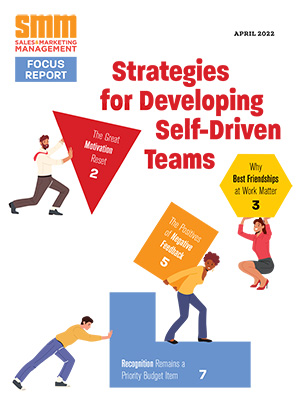
“If you buy the wrong brand of peanut butter, you can always buy another brand when you finish the jar.
The wrong trio of underwear, you might be out $14.99. But buy the wrong computer software or hardware solution for your business and you have a major problem,” says Paul Regensburg, president and creative director at RainCastle, a Boston-based brand and marketing consultancy. “Brands matter in the B2B world, sometimes more than B2C. A strong brand means the perception of reduced risk and makes doing business — whatever the business — easier. As with B2C, buyers of B2B products value vendors’ reputation because it makes the purchase decision safer.”
Though your company may not have a dedicated brand strategist, simply by virtue of the fact that you have a business name and provide a product or service means that you are a brand capable of being perceived a certain way by your target market. The ability of your clients, prospects and employees to share a common view of your organization, the results of your marketing programs, and whether or not your website generates leads, are all predicated on first having a sound brand strategy in place.
Harvard Business School Professor John Quelch says B2B marketers are realizing that developing brand awareness among their customers’ customers can capture a larger share of channel margins and build loyalty that can protect them against lower-priced competitors.
Establish a brand foundation
Brand leaders at Bop Design, a San Diego-based full-service B2B branding firm, state that brands are built and cultivated over many years, adding that there are many factors that play into a brand’s success. Managing your brand starts with creating a solid brand foundation, they say. A solid brand foundation:
• Communicates to your clients that your business understands their needs.
• Explains to clients why your business stands out from the competition.
• Helps clients remember your business’ unique traits.
• Informs your employees about exactly what your company stands for, which assists in their daily business decision-making.
A report from McKinsey & Company states, “Decision makers are willing to pay a premium for strong brands because established brands make their lives easier. They aggregate information and reduce risk. Strong supplier brands may even aid companies in building their own reputation by association.”
McKinsey surveyed more than 700 executives with substantial influence on supplier selection in the United States, Germany and India. It found that, as with consumers, business buyers’ purchase decisions tend to be a lot less value-driven than they like to think. Like consumers, professional buyers
use the vendor’s reputation as a short cut that reduces risk and simplifies the evaluation process.
In fact, the McKinsey survey found that B2B purchasing decision makers consider the brand as a central rather than a marginal element of a supplier’s value proposition. Decision makers say that brand is almost as important as the efforts of sales teams in encouraging them to make out a purchase order. In the U.S., for example, brands are seen as having an 18 percent share in the purchasing decision, compared to the 17 percent tied up in the sales effort. Brands are perceived as particularly relevant in tangible goods sectors, such as machines and components, and somewhat less so in some less tangible sectors, such as utilities and financial services, according to the survey.
Branding accelerates the B2B buying process
To understand why B2B branding is one of the most important factors affecting the sales cycle, it’s necessary to review the five stages of the B2B buying process, says Jennifer Nagy, president of JLNPR Inc., a full-service marketing firm.
• Need recognition
• Information search
• Alternative evaluation
• Purchase decision
• Post-purchase behavior
Before beginning the initial research (stage two), consumers will wrack their brains to see if they are already aware of a company offering the solution that they need. Before doing a Google search to cast a wide net for potential suppliers, they will research the companies that they already know of, and will often use these companies’ offerings as a baseline to compare all other products to during this stage. “If potential customers are aware of your company, product or service, you are more likely to be one of the final vendors they evaluate in stage three of the buying cycle,” Nagy says.
Brand awareness greatly reduces the time it takes to complete the sales cycle, she adds. If your company is well-known in your industry, prospects already trust that you are an expert, and they are more likely to respond positively to a sales pitch. In other words, it takes less convincing to convert a potential customer who is already aware of you and who already finds your company credible. Nagy says content marketing — publishing and distributing informative and engaging content with the intention of driving action — is among the most effective means of building your B2B brand.
The emotional benefits of branding
Regensburg cites research by Mohanbir Sawhney, professor of technology at Northwestern’s Kellog School of Management, that shows that brands that deliver beyond the functional and economic levels with emotional benefits will command an incremental price premium and create strong competitive advantage and customer brand loyalty.
“B2B sellers tend to talk in terms of product features, performance and ROI. B2B buyers may be looking for all that, but at heart they’re also looking for trust, confidence, ease, security and to be associated with a leader,” Regensburg says.
“I can’t think of a technology B2B company that has understood this better than Salesforce.com,” he adds. “Salesforce.com started with a seemingly simplistic brand vision — no software. Rather than focusing on its myriad features, they leveraged emotion. Recognizing that sales teams were incredibly frustrated with the complexity of using, maintaining and updating sales and marketing software, they built a brand around relieving that pain, and in the process, accelerated the revolution in business known as software as
a service (SAAS). In the years since they’ve ascended to the pinnacle of B2B brands, Salesforce.com never lost sight of the simplicity of the emotionally driven ‘no software’ message, and have built a formidable ecosystem of products and services to expand the vision.”
Maintaining the brand you’ve developed
Once you have established your brand identity, the consultants at Bop Design say there are three golden rules to maintaining brand integrity:
• Clarity – Develop a clear and concise message about what your brand stands for, its internal values and attitude, and how you are different from your competitors.
• Unity – Make sure that each department in your business is educated about the importance of a unified brand strategy and that every department understands how their piece fits into the whole of your company’s brand identity.
• Consistency – Check in regularly with each department to ensure that the elements of your brand are being implemented on a consistent basis across all platforms.
A slip in one area can create confusion among clients and can chip away at your unified brand message.
“Your brand is more than just your logo or your tagline. It’s about the internal and external environment of your business — and how you choose to communicate within it,” says Kara Jensen, creative principal at Bop Design. “Everything your business does and says reflects on our brand, so it’s important to maximize its potential.”



